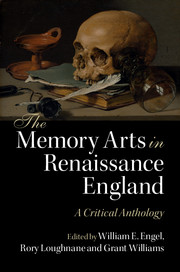Book contents
- Frontmatter
- Dedication
- Contents
- List of figures
- Acknowledgements
- A note on abbreviations
- Introduction
- PART I The art of memory
- PART II Rhetoric and poetics
- PART III Education and science
- PART IV History and philosophy
- PART V Religion and devotion
- PART VI Literature
- Introduction to Part VI
- POETRY
- VI.1 John Skelton, ‘Upon a Dead Man's Head’ (1527)
- VI.2 Edmund Spenser, The Faerie Queene (1590)
- VI.3 Anthony Sherley, Wit's New Dial (1604)
- VI.4 Richard Niccols, Mirror for Magistrates (1610)
- VI.5 Abraham Holland, ‘A Funeral Elegy’ (1626)
- VI.6 George Herbert, The Temple (1633)
- VI.7 Francis Quarles, Emblems (1635)
- VI.8 Mary Fage, Fame's Rule (1637)
- VI.9 Margaret Cavendish, selected works
- VI.10 John Milton, Paradise Lost (1674)
- PLAYS AND PROSE
- Index
- References
VI.2 - Edmund Spenser, The Faerie Queene (1590)
from POETRY
Published online by Cambridge University Press: 05 August 2016
- Frontmatter
- Dedication
- Contents
- List of figures
- Acknowledgements
- A note on abbreviations
- Introduction
- PART I The art of memory
- PART II Rhetoric and poetics
- PART III Education and science
- PART IV History and philosophy
- PART V Religion and devotion
- PART VI Literature
- Introduction to Part VI
- POETRY
- VI.1 John Skelton, ‘Upon a Dead Man's Head’ (1527)
- VI.2 Edmund Spenser, The Faerie Queene (1590)
- VI.3 Anthony Sherley, Wit's New Dial (1604)
- VI.4 Richard Niccols, Mirror for Magistrates (1610)
- VI.5 Abraham Holland, ‘A Funeral Elegy’ (1626)
- VI.6 George Herbert, The Temple (1633)
- VI.7 Francis Quarles, Emblems (1635)
- VI.8 Mary Fage, Fame's Rule (1637)
- VI.9 Margaret Cavendish, selected works
- VI.10 John Milton, Paradise Lost (1674)
- PLAYS AND PROSE
- Index
- References
Summary
About the author
Edmund Spenser (1552?– 99), England's first great epic poet, held a number of administrative posts in Ireland. The Faerie Queene, his magnum opus, was dedicated to Elizabeth I, who, a year after its publication in 1590, awarded Spenser a lifetime pension of £50 per annum.
Book I, canto 4
About the text
Book I tells the romance tale of Redcrosse knight, who, in the name of Gloriana (Glory, representing Elizabeth I), undertakes a quest to defeat the Satanic figure of a dragon (representing Sin and the Church of Rome) inspired by the Book of Revelation. Our excerpt belongs to the fourth canto, where Duessa (i.e. falsehood) leads Redcrosse (the knight of holiness) to the palatial House of Pride. There they watch as Queen Lucifera – the personification of the cardinal sin of Pride – is paraded in a coach, drawn by six beasts, each carrying one of her ‘six sage counsellors’. Her counsellors personify the remaining cardinal sins: Idleness, Gluttony, Lechery, Avarice, Envy and Wrath.
The arts of memory
Contrasted with the Seven Holy or Cardinal Virtues, the Seven Deadly Sins were extremely popular in the medieval emblematic and homiletic traditions. Such a taxonomy of vice originated in the fourth-century writings of Evagrius Ponticus. Pope Gregory I revised this list in 590, and refined, defined and ordered the Seven Deadly Sins into their modern incarnation. Spenser adopts a set routine for his iconographic representation of the sins. Over three stanzas, Spenser describes each counsellor's appearance and attire, an object associated with him, the malady he suffers from and the beast upon which he rides. Each vice is also paired with another sinful companion – in our excerpt Idleness rides alongside Gluttony. Following the Scholastic appropriation of the memory arts, Spenser splices together the tableau vivant of sins with the didactic imperative to dwell habitually upon prudential Christian behaviour. He makes memorable the ridiculous absurdity of vice, its empty pomp, lack of direction, and entropy.
Textual notes
Edmund Spenser, The Faerie Qveene disposed into twelue books, fashioning XII. morall vertues (London, 1590) D2v–D3r; X2v–X3v. Because Spenser wrote in a mock medieval vein with archaic diction, the excerpts’ spelling and punctuation have not been modernised for fear of tampering with Spenser's poetic choices.
- Type
- Chapter
- Information
- The Memory Arts in Renaissance EnglandA Critical Anthology, pp. 283 - 290Publisher: Cambridge University PressPrint publication year: 2016



